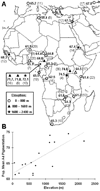The genetic basis of adaptive pigmentation variation in Drosophila melanogaster
- PMID: 17614900
- PMCID: PMC2650379
- DOI: 10.1111/j.1365-294X.2007.03324.x
The genetic basis of adaptive pigmentation variation in Drosophila melanogaster
Abstract
In a broad survey of Drosophila melanogaster population samples, levels of abdominal pigmentation were found to be highly variable and geographically differentiated. A strong positive correlation was found between dark pigmentation and high altitude, suggesting adaptation to specific environments. DNA sequence polymorphism at the candidate gene ebony revealed a clear association with the pigmentation of homozygous third chromosome lines. The darkest lines sequenced had nearly identical haplotypes spanning 14.5 kb upstream of the protein-coding exons of ebony. Thus, natural selection may have elevated the frequency of an allele that confers dark abdominal pigmentation by influencing the regulation of ebony.
Figures



Comment in
-
Annotating ebony on the fly.Mol Ecol. 2007 Jul;16(14):2831-3. doi: 10.1111/j.1365-294X.2007.03380.x. Mol Ecol. 2007. PMID: 17614896
Similar articles
-
Divergent enhancer haplotype of ebony on inversion In(3R)Payne associated with pigmentation variation in a tropical population of Drosophila melanogaster.Mol Ecol. 2011 Oct;20(20):4277-87. doi: 10.1111/j.1365-294X.2011.05260.x. Epub 2011 Sep 13. Mol Ecol. 2011. PMID: 21914015
-
Genetic Architecture of Abdominal Pigmentation in Drosophila melanogaster.PLoS Genet. 2015 May 1;11(5):e1005163. doi: 10.1371/journal.pgen.1005163. eCollection 2015 May. PLoS Genet. 2015. PMID: 25933381 Free PMC article.
-
Natural variation of ebony gene controlling thoracic pigmentation in Drosophila melanogaster.Genetics. 2007 Oct;177(2):1233-7. doi: 10.1534/genetics.107.075283. Epub 2007 Jul 29. Genetics. 2007. PMID: 17660557 Free PMC article.
-
Pigmentation and behavior: potential association through pleiotropic genes in Drosophila.Genes Genet Syst. 2013;88(3):165-74. doi: 10.1266/ggs.88.165. Genes Genet Syst. 2013. PMID: 24025245 Review.
-
The Genetic Basis of Pigmentation Differences Within and Between Drosophila Species.Curr Top Dev Biol. 2016;119:27-61. doi: 10.1016/bs.ctdb.2016.03.004. Epub 2016 Apr 25. Curr Top Dev Biol. 2016. PMID: 27282023 Free PMC article. Review.
Cited by
-
A Variable Genetic Architecture of Melanic Evolution in Drosophila melanogaster.Genetics. 2016 Nov;204(3):1307-1319. doi: 10.1534/genetics.116.192492. Epub 2016 Sep 16. Genetics. 2016. PMID: 27638419 Free PMC article.
-
Expanding the CRISPR base editing toolbox in Drosophila melanogaster.Commun Biol. 2024 Sep 12;7(1):1126. doi: 10.1038/s42003-024-06848-5. Commun Biol. 2024. PMID: 39266668 Free PMC article.
-
Functional genomics implicates ebony in the black pupae phenotype of tephritid fruit flies.Commun Biol. 2025 Jan 15;8(1):60. doi: 10.1038/s42003-025-07489-y. Commun Biol. 2025. PMID: 39814836 Free PMC article.
-
Using environmental correlations to identify loci underlying local adaptation.Genetics. 2010 Aug;185(4):1411-23. doi: 10.1534/genetics.110.114819. Epub 2010 Jun 1. Genetics. 2010. PMID: 20516501 Free PMC article.
-
The role of the epidermis enhancer element in positive and negative transcriptional regulation of ebony in Drosophila melanogaster.G3 (Bethesda). 2022 Mar 4;12(3):jkac010. doi: 10.1093/g3journal/jkac010. G3 (Bethesda). 2022. PMID: 35100378 Free PMC article.
References
-
- Begun DJ, Aquadro CF. African and North American populations of Drosophila melanogaster are very different at the DNA level. Nature. 1993;365:548–550. - PubMed
-
- Brisson JA, De Toni DC, Duncan I, Templeton AR. Abdominal pigmentation variation in Drosophila polymorpha, Geographic variation in the trait, and underlying phylogeography. Evolution. 2005;59:1046–1059. - PubMed
-
- Da Costa BEP, Rohde C, da Silva Valente VL. Temperature, urbanization and body color polymorphism in south Brazilian populations of Drosophila kikkawai (diptera, Drosophilidae) Iheringia Série Zoologia. 2003;93:381–393.
Publication types
MeSH terms
Substances
Associated data
- Actions
- Actions
- Actions
- Actions
- Actions
- Actions
- Actions
- Actions
- Actions
- Actions
- Actions
- Actions
- Actions
- Actions
- Actions
- Actions
- Actions
- Actions
- Actions
- Actions
- Actions
Grants and funding
LinkOut - more resources
Full Text Sources
Molecular Biology Databases

